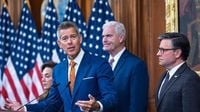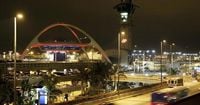On Sunday, October 26, 2025, travelers at Los Angeles International Airport (LAX) awoke to an unwelcome surprise: a temporary ground stop, triggered by a shortage of air traffic controllers, brought one of the world’s busiest airports to a standstill. The disruption, which began at 8:42 a.m. local time (11:42 a.m. Eastern), was a stark reminder of the far-reaching consequences of the ongoing federal government shutdown that has gripped the nation since October 1.
According to the Federal Aviation Administration (FAA), the ground stop at LAX was implemented due to staffing shortages at a Southern California air traffic facility. Planes bound for Los Angeles were held at their originating airports, resulting in delays that averaged an hour and 40 minutes. The order specifically affected departing flights from Oakland, but the ripple effects extended far beyond California.
The FAA lifted the ground stop just after 10:30 a.m. Pacific time, but officials warned that further restrictions could continue to hamper traffic into LAX. Even after flights resumed, passengers faced lingering delays and were urged to monitor their flight status closely. The Associated Press reported that the effects of the staffing crisis were not limited to Los Angeles; Newark Liberty International Airport and Teteboro Airport in New Jersey, as well as Southwest Florida International Airport in Fort Myers, also experienced disruptions due to similar shortages.
The chaos at LAX and other major airports is only the latest chapter in a saga that has unfolded over nearly four weeks of government shutdown. Air traffic controllers, deemed essential workers, are required to work without pay whenever the federal government grinds to a halt. They won’t receive retroactive pay until Congress resolves the budget impasse—a prospect that seems remote as Republicans and Democrats remain deadlocked in Washington.
U.S. Transportation Secretary Sean Duffy, speaking on Fox News’ “Sunday Morning Futures,” painted a grim picture of the mounting strain on the nation’s air traffic controllers. “Just yesterday, ... we had 22 staffing triggers. That’s one of the highest that we have seen in the system since the shutdown began. And that’s a sign that the controllers are wearing thin,” Duffy said. He added, “I’ve been out talking to air traffic controllers and you can see the stress. These are people that oftentimes live paycheck to paycheck or one controller has a stay-at-home spouse. They’re concerned about gas in the car, they’re concerned about child care and mortgages.”
It’s not just the seasoned professionals who are feeling the heat. At the FAA’s academy in Oklahoma City, some students and new hires have begun abandoning their careers before they’ve even started, unwilling to work in a profession where paychecks are not guaranteed. “We’re getting word back right now from our academy in Oklahoma City that some of our young controllers in the academy and some who have been given spots in the next class of the academy are bailing. They’re walking away,” Duffy said at a news conference Friday at the Philadelphia airport. “They’re asking themselves, why do I want to go into a profession where I could work hard and have the potential of not being paid for my services?”
The exodus of new recruits spells trouble for the FAA’s long-term staffing levels, especially since training qualified controllers takes years. The agency is already critically short-staffed, and just a handful of absences can trigger widespread disruptions. In fact, the number of flight delays nationwide surged to 6,158 on Thursday, October 23—up from about 4,000 per day earlier in the week, according to FlightAware.com. As Duffy warned, “the disruptions and delays will only get worse next week after Tuesday’s payday arrives and their paycheck is going to be a big fat zero.”
Nick Daniels, head of the air traffic controllers union, highlighted the human cost of the shutdown. “As this shutdown continues, and air traffic controllers are not paid for the vital work that they do day in and day out, that leads to an unnecessary distraction,” Daniels said. “They cannot be 100% focused on their jobs, which makes this system less safe. Every day that this shutdown continues, tomorrow, we’ll be less safe than today.”
The financial strain has forced some controllers to take on second jobs, delivering food for DoorDash or driving for Uber, just to cover basic expenses. Airlines and airports have stepped in to help, providing meals and connecting staff with food banks and other services. The greatest concern is for new controllers, who might make less than $50,000 a year, but even experienced professionals earning six figures are now living paycheck to paycheck, with little room for error in their budgets. Daniels lamented, “It’s not fair that controllers are facing impossible choices about whether to pay for rent or child care or groceries.”
While LAX grabbed headlines with its ground stop, the staffing crisis has played out at airports across the country all month. Early in October, dozens of flights were delayed and 12 canceled at Hollywood Burbank Airport when the control tower was unstaffed. On the same Sunday as the LAX stoppage, the FAA listed several major airports—including Ronald Reagan Washington National Airport and Philadelphia International Airport—as experiencing “staffing triggers.” Later that evening, the FAA slowed traffic into Ronald Reagan Washington National and Chicago O’Hare International Airport because of controller shortages.
Political leaders have not been shy about weighing in. California Governor Gavin Newsom’s press office took to social media to criticize Secretary Duffy’s handling of the situation, posting, “Hell of a job, @SecDuffy. Can’t wait to see what you do with NASA.” The jab reflects the growing frustration among state and local officials who are powerless to resolve a crisis that is, at its core, a federal issue.
This is hardly the first time a government shutdown has threatened the nation’s aviation system. In January 2019, a wave of air traffic controllers called in sick in New York City, prompting the FAA to halt flights into LaGuardia Airport. The resulting chaos and safety concerns ultimately pushed lawmakers to reach a deal. This time, however, the political stalemate seems even more entrenched, and there’s little sign of compromise on the horizon.
Meanwhile, the traveling public bears the brunt of the disruption. Passengers at LAX and other affected airports faced delays ranging from 49 minutes to nearly an hour and a half, with some waiting even longer. As the shutdown drags on, the FAA and industry leaders warn that these headaches may soon become the new normal—unless Congress can break the impasse and restore stability to the nation’s airways.
For now, air traffic controllers continue to report for duty, keeping planes and passengers safe despite mounting stress and empty paychecks. But as the shutdown enters its fifth week, the strain is beginning to show, and the future of America’s aviation system hangs in the balance.

